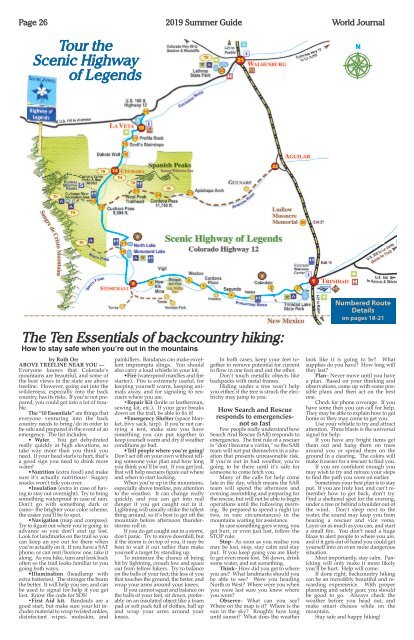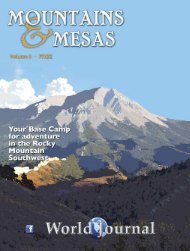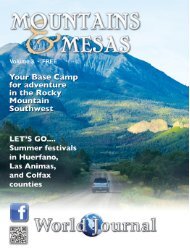2019 Summer Guide
Guide to businesses and activities year-round around the Scenic Highway of Legends in southern Colorado
Guide to businesses and activities year-round around the Scenic Highway of Legends in southern Colorado
Create successful ePaper yourself
Turn your PDF publications into a flip-book with our unique Google optimized e-Paper software.
Page 26 <strong>2019</strong> <strong>Summer</strong> <strong>Guide</strong> World Journal<br />
Tour the<br />
Scenic Highway<br />
of Legends<br />
The Ten Essentials of backcountry hiking:<br />
How to stay safe when you’re out in the mountains<br />
by ruth orr<br />
aBoVe treeline near you —<br />
Everyone knows that Colorado’s<br />
mountains are beautiful, and some of<br />
the best views in the state are above<br />
treeline. However, going out into the<br />
wilderness, especially into the back<br />
country, has its risks. If you’re not prepared,<br />
you could get into a lot of trouble.<br />
the “10 essentials” are things that<br />
everyone venturing into the back<br />
country needs to bring/do in order to<br />
be safe and prepared in the event of an<br />
emergency. The list includes:<br />
• Water. You get dehydrated<br />
really quickly at high elevations, so<br />
take way more than you think you<br />
need. If your head starts to hurt, that’s<br />
a good sign you need to drink more<br />
water!<br />
•nutrition (extra food) and make<br />
sure it’s actually nutritious! Sugary<br />
snacks won’t tide you over.<br />
•insulation (extra in case of having<br />
to stay out overnight). Try to bring<br />
something waterproof in case of rain.<br />
Don’t go with something dark or<br />
camo– the brighter your color scheme,<br />
the easier you’ll be to spot.<br />
•navigation (map and compass).<br />
Try to figure out where you’re going in<br />
advance so you don’t end up lost.<br />
Look for landmarks on the trail so you<br />
can keep an eye out for them when<br />
you’re actually on it. If you have a SAT<br />
phone, or can rent/borrow one, take it<br />
along. As you hike, turn and look back<br />
often so the trail looks familiar to you<br />
going both ways.<br />
•illumination (headlamp with<br />
extra batteries). The stronger the beam<br />
the better. It will help you see, and can<br />
be used to signal for help if you get<br />
lost. Know the code for SOS!<br />
•First aid kit. Bandaids are a<br />
good start, but make sure your kit includes<br />
material to wrap twisted ankles,<br />
disinfectant wipes, moleskin, and<br />
painkillers. Bandanas can make excellent<br />
impromptu slings. You should<br />
also carry a loud whistle in your kit.<br />
•Fire (waterproof matches and fire<br />
starter). Fire is extremely useful, for<br />
keeping yourself warm, keeping animals<br />
away, and for signaling to rescuers<br />
where you are.<br />
•repair kit (knife or leatherman,<br />
sewing kit, etc.). If your gear breaks<br />
down on the trail, be able to fix it!<br />
•emergency Shelter (space blanket,<br />
bivy sack, tarp). If you’re not carrying<br />
a tent, make sure you have<br />
something you can put together to<br />
keep yourself warm and dry if weather<br />
conditions go bad.<br />
•tell people where you’re going!<br />
Don’t set off on your own without telling<br />
someone your plan and how long<br />
you think you’ll be out. If you get lost,<br />
that will help rescuers figure out where<br />
and when to start looking.<br />
When you’re up in the mountains,<br />
especially above treeline, pay attention<br />
to the weather. It can change really<br />
quickly, and you can get into real<br />
danger if you get caught out in it.<br />
Lightning will usually strike the tallest<br />
thing around, so it’s best to get off the<br />
mountain before afternoon thunderstorms<br />
roll in.<br />
If you do get caught out in a storm,<br />
don’t panic. Try to move downhill, but<br />
if the storm is on top of you, it may be<br />
best to wait it out rather than make<br />
yourself a target by standing up.<br />
To minimize the chance of being<br />
hit by lightning, crouch low and space<br />
out from fellow hikers. Try to balance<br />
on the balls of your feet; the less of you<br />
that touches the ground, the better, and<br />
wrap your arms around your knees.<br />
If you cannot squat and balance on<br />
the balls of your feet, sit down, preferably<br />
on an insulated object like a foam<br />
pad or soft pack full of clothes, ball up<br />
and wrap your arms around your<br />
knees.<br />
In both cases, keep your feet together<br />
to remove potential for current<br />
to flow in one foot and out the other.<br />
Don’t touch metallic objects like<br />
backpacks with metal frames.<br />
Hiding under a tree won’t help<br />
you either, if the tree is struck the electricity<br />
may jump to you.<br />
how Search and rescue<br />
responds to emergenciesnot<br />
so fast<br />
Few people really understand how<br />
Search And Rescue (SAR) responds to<br />
emergencies. The first rule of a rescuer<br />
is “don’t become a victim,” so the SAR<br />
team will not put themselves in a situation<br />
that presents unreasonable risk.<br />
If you’re out in bad weather, you’re<br />
going to be there until it’s safe for<br />
someone to come fetch you.<br />
Many of the calls for help come<br />
late in the day, which means the SAR<br />
team will spend the afternoon and<br />
evening assembling and preparing for<br />
the rescue, but will not be able to begin<br />
operations until the following morning.<br />
Be prepared to spend a night (or<br />
two, in rare circumstances) in the<br />
mountains waiting for assistance.<br />
In case something goes wrong, you<br />
get hurt, or even just lost, follow the<br />
STOP rule:<br />
Stop– As soon as you realise you<br />
may be lost, stop, stay calm and stay<br />
put. If you keep going you are likely<br />
to get even more lost. Sit down, drink<br />
some water, and eat something.<br />
think– How did you get to where<br />
you are? What landmarks should you<br />
be able to see? Were you heading<br />
North or West? Where were you when<br />
you were last sure you knew where<br />
you were?<br />
observe– What can you see?<br />
Where on the map is it? Where is the<br />
sun in the sky? Roughly how long<br />
until sunset? What does the weather<br />
Numbered Route<br />
Details<br />
on pages 18-21<br />
look like it is going to be? What<br />
supplies do you have? How long will<br />
they last?<br />
plan– Never move until you have<br />
a plan. Based on your thinking and<br />
observations, come up with some possible<br />
plans and then act on the best<br />
one.<br />
Check for phone coverage. If you<br />
have some then you can call for help.<br />
They may be able to explain how to get<br />
home or they may come to get you.<br />
Use your whistle to try and attract<br />
attention. Three blasts is the universal<br />
signal for help.<br />
If you have any bright items get<br />
them out and hang them on trees<br />
around you or spread them on the<br />
ground in a clearing. The colors will<br />
make it easier for a rescuer to find you.<br />
If you are confident enough you<br />
may wish to try and retrace your steps<br />
to find the path you were on earlier.<br />
Sometimes your best plan is to stay<br />
put. If you are truly lost, and can’t remember<br />
how to get back, don’t try.<br />
Find a sheltered spot for the evening,<br />
under a tree or behind a boulder out of<br />
the wind. Don’t sleep next to the<br />
water, the sound may keep you from<br />
hearing a rescuer and vice versa.<br />
Layer on as much as you can, and start<br />
a small fire. You don’t need a huge<br />
blaze to alert people to where you are,<br />
and if it gets out of hand you could get<br />
yourself into an even more dangerous<br />
situation.<br />
Most importantly, stay calm. Panicking<br />
will only make it more likely<br />
you’ll be hurt. Help will come.<br />
If done right, backcountry hiking<br />
can be an incredibly beautiful and rewarding<br />
expereience. With proper<br />
planning and safety gear, you should<br />
be good to go. Always check the<br />
weather before you head out, and<br />
make smart choices while on the<br />
mountain.<br />
Stay safe and happy hiking!















